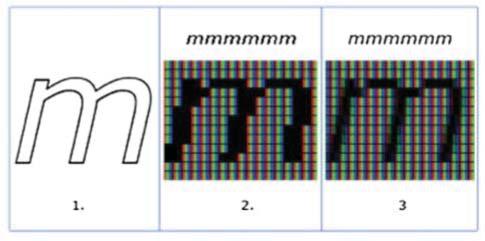IntroductiontoFlatPanelDisplays
Jiun-HawLee NationalTaiwanUniversity TaipeiCity,Taiwan
I-ChunCheng NationalTaiwanUniversity TaipeiCity,Taiwan
HongHua UniversityofArizona Arizona,USA
Shin-TsonWu UniversityofCentralFlorida Florida,USA
SecondEdition
Thiseditionfirstpublished2020
©2020JohnWiley&SonsLtd
EditionHistory: 1eWiley,2008
Allrightsreserved.Nopartofthispublicationmaybereproduced,storedinaretrievalsystem,ortransmitted,inanyformorbyany means,electronic,mechanical,photocopying,recordingorotherwise,exceptaspermittedbylaw.Adviceonhowtoobtainpermission toreusematerialfromthistitleisavailableathttp://www.wiley.com/go/permissions.
TherightofJiun-HawLee,I-ChunCheng,HongHuaandShin-TsonWutobeidentifiedastheauthorsofthisworkhavebeenasserted inaccordancewithlaw.
RegisteredOffices
JohnWiley&Sons,Inc.,111RiverStreet,Hoboken,NJ07030,USA
JohnWiley&SonsLtd,TheAtrium,SouthernGate,Chichester,WestSussex,PO198SQ,UK
EditorialOffice
TheAtrium,SouthernGate,Chichester,WestSussex,PO198SQ,UK
Fordetailsofourglobaleditorialoffices,customerservices,andmoreinformationaboutWileyproductsvisitusatwww.wiley.com.
Wileyalsopublishesitsbooksinavarietyofelectronicformatsandbyprint-on-demand.Somecontentthatappearsinstandardprint versionsofthisbookmaynotbeavailableinotherformats.
LimitofLiability/DisclaimerofWarranty
Inviewofongoingresearch,equipmentmodifications,changesingovernmentalregulations,andtheconstantflowofinformation relatingtotheuseofexperimentalreagents,equipment,anddevices,thereaderisurgedtoreviewandevaluatetheinformation providedinthepackageinsertorinstructionsforeachchemical,pieceofequipment,reagent,ordevicefor,amongotherthings,any changesintheinstructionsorindicationofusageandforaddedwarningsandprecautions.Whilethepublisherandauthorshaveused theirbesteffortsinpreparingthiswork,theymakenorepresentationsorwarrantieswithrespecttotheaccuracyorcompletenessofthe contentsofthisworkandspecificallydisclaimallwarranties,includingwithoutlimitationanyimpliedwarrantiesofmerchantabilityor fitnessforaparticularpurpose.Nowarrantymaybecreatedorextendedbysalesrepresentatives,writtensalesmaterialsorpromotional statementsforthiswork.Thefactthatanorganization,website,orproductisreferredtointhisworkasacitationand/orpotential sourceoffurtherinformationdoesnotmeanthatthepublisherandauthorsendorsetheinformationorservicestheorganization, website,orproductmayprovideorrecommendationsitmaymake.Thisworkissoldwiththeunderstandingthatthepublisherisnot engagedinrenderingprofessionalservices.Theadviceandstrategiescontainedhereinmaynotbesuitableforyoursituation.You shouldconsultwithaspecialistwhereappropriate.Further,readersshouldbeawarethatwebsiteslistedinthisworkmayhavechanged ordisappearedbetweenwhenthisworkwaswrittenandwhenitisread.Neitherthepublishernorauthorsshallbeliableforanylossof profitoranyothercommercialdamages,includingbutnotlimitedtospecial,incidental,consequential,orotherdamages.
LibraryofCongressCataloging-in-PublicationData
Names:Lee,Jiun-Haw,author.|Cheng,I-Chun,1974-author.|Hua,Hong, 1973-author.|Wu,Shin-Tson,author.
Title:Introductiontoflatpaneldisplays/Jiun-HawLee,NationalTaiwan University,TaipeiCity,Taiwan,I-ChunCheng,NationalTaiwanUniversity, TaipeiCity,Taiwan,HongHua,UniversityofArizona,Arizona,USA, Shin-TsonWu,UniversityofCentralFlorida,Florida,USA.
Description:Secondedition.|Hoboken,NJ:JohnWiley&Sons,Inc., [2020]|Series:Wiley-SIDseriesindisplaytechnology|Includes bibliographicalreferencesandindex.
Identifiers:LCCN2020004365(print)|LCCN2020004366(ebook)|ISBN 9781119282273(cloth)|ISBN9781119282198(adobepdf)|ISBN 9781119282228(epub)
Subjects:LCSH:Flatpaneldisplays.
Classification:LCCTK7882.I6L4362020(print)|LCCTK7882.I6(ebook)| DDC621.3815/422—dc23
LCrecordavailableathttps://lccn.loc.gov/2020004365
LCebookrecordavailableathttps://lccn.loc.gov/2020004366
CoverDesign:Wiley
CoverImage:YuichiroChino/GettyImages
Setin10/12ptWarnockProbySPiGlobal,Chennai,India
Contents
SeriesEditor’sForeword xiii
1FlatPanelDisplays 1
1.1Introduction 1
1.2Emissiveandnon-emissiveDisplays 4
1.3DisplaySpecifications 4
1.3.1PhysicalParameters 5
1.3.2BrightnessandColor 7
1.3.3ContrastRatio 8
1.3.4SpatialandTemporalCharacteristics 8
1.3.5EfficiencyandPowerConsumption 9
1.3.6FlexibleDisplays 9
1.4ApplicationsofFlatPanelDisplays 9
1.4.1LiquidCrystalDisplays 10
1.4.2Light-EmittingDiodes 10
1.4.3OrganicLight-EmittingDevices 11
1.4.4ReflectiveDisplays 11
1.4.5Head-MountedDisplays 12
1.4.6TouchPanelTechnologies 12 References 13
2ColorScienceandEngineering 15
2.1Introduction 15
2.2Photometry 16
2.3TheEye 18
2.4Colorimetry 22
2.4.1TrichromaticSpace 22
2.4.2CIE1931ColormetricObserver 24
2.4.3CIE1976UniformColorSystem 27
2.4.4CIECAM02ColorAppearanceModel 30
2.4.5ColorGamut 31
2.4.6LightSources 32
2.4.6.1SunlightandBlackbodyRadiators 32
2.4.6.2LightSourcesforTransmissive,Reflective,andProjectionDisplays 33
2.4.6.3ColorRenderingIndex 34
2.5ProductionandReproductionofColors 34
2.6DisplayMeasurements 35 HomeworkProblems 36 References 36
3ThinFilmTransistors 39
3.1Introduction 39
3.2BasicConceptsofCrystallineSemiconductorMaterials 39
3.2.1BandStructureofCrystallineSemiconductors 40
3.2.2IntrinsicandExtrinsicSemiconductors 43
3.3ClassificationofSiliconMaterials 46
3.4HydrogenatedAmorphousSilicon(a-Si:H) 46
3.4.1ElectronicStructureofa:Si-H 47
3.4.2CarrierTransportina-Si:H 48
3.4.3Fabricationofa-Si:H 48
3.5PolycrystallineSilicon 49
3.5.1CarrierTransportinPolycrystallineSilicon 49
3.5.2FabricationofPolycrystalline-Silicon 50
3.6Thin-FilmTransistors 52
3.6.1FundamentalsofTFTs 52
3.6.2a-Si:HTFTs 55
3.6.3Poly-SiTFTs 55
3.6.4OrganicTFTs 56
3.6.5OxideSemiconductorTFTs 57
3.6.6FlexibleTFTTechnology 59
3.7PMandAMDrivingSchemes 61 HomeworkProblems 67 References 67
4LiquidCrystalDisplays 71
4.1Introduction 71
4.2TransmissiveLCDs 72
4.3LiquidCrystalMaterials 74
4.3.1PhaseTransitionTemperatures 75
4.3.2EutecticMixtures 75
4.3.3DielectricConstants 77
4.3.4ElasticConstants 78
4.3.5RotationalViscosity 79
4.3.6OpticalProperties 80
4.3.7RefractiveIndices 80
4.3.7.1WavelengthEffect 80
4.3.7.2TemperatureEffect 82
4.4LiquidCrystalAlignment 83
4.5HomogeneousCell 84
4.5.1PhaseRetardationEffect 85
4.5.2VoltageDependentTransmittance 86
4.6TwistedNematic(TN) 87
4.6.1OpticalTransmittance 87
4.6.2ViewingAngle 89
4.6.3Film-CompensatedTN 90
4.7In-PlaneSwitching(IPS) 91
4.7.1DeviceStructure 92
4.7.2Voltage-DependentTransmittance 92
4.7.3ViewingAngle 92
4.7.4PhaseCompensationFilms 93
4.8FringeFieldSwitching(FFS) 95
4.8.1DeviceConfigurations 95
4.8.2n-FFSversusp-FFS 96
4.9VerticalAlignment(VA) 98
4.9.1Voltage-DependentTransmittance 98
4.9.2ResponseTime 99
4.9.3OverdriveandUndershootAddressing 101
4.9.4Multi-domainVerticalAlignment(MVA) 102
4.10AmbientContrastRatio 103
4.10.1ModelingofAmbientContrastRatio 103
4.10.2AmbientContrastRatioofLCD 103
4.10.3AmbientContrastRatioofOLED 104
4.10.4SimulatedACRforMobileDisplays 105
4.10.5SimulatedACRforTVs 105
4.10.6SimulatedAmbientIsocontrastContour 106
4.10.6.1MobileDisplays 106
4.10.6.2Large-SizedTVs 108
4.10.7ImprovingLCD’sACR 109
4.10.8ImprovingOLED’sACR 110
4.11MotionPictureResponseTime(MPRT) 112
4.12WideColorGamut 114
4.12.1MaterialSynthesisandCharacterizations 115
4.12.2DeviceConfigurations 116
4.13HighDynamicRange 118
4.13.1Mini-LEDBacklitLCDs 118
4.13.2Dual-PanelLCDs 120
4.14FutureDirections 121 HomeworkProblems 123 References 124
5Light-EmittingDiodes 135
5.1Introduction 135
5.2MaterialSystems 138
5.2.1AlGaAsandAlGaInPMaterialSystemsforRedandYellowLEDs 140
5.2.2GaN-BasedSystemsforGreen,Blue,UVandUVLEDs 141
5.2.3WhiteLEDs 143
5.3DiodeCharacteristics 146
5.3.1p-andn-Layer 147
5.3.2DepletionRegion 148
5.3.3J–VCharacteristics 150
5.3.4HeterojunctionStructures 152
5.3.5Quantum-Well,-Wire,and-DotStructures 152
5.4Light-EmittingCharacteristics 154
x Contents
5.4.1RecombinationModel 154
5.4.2L-JCharacteristics 155
5.4.3SpectralCharacteristics 156
5.4.4EfficiencyDroop 159
5.5DeviceFabrication 160
5.5.1Epitaxy 161
5.5.2ProcessFlowandDeviceStructureDesign 165
5.5.3ExtractionEfficiencyImprovement 166
5.5.4Packaging 168
5.6Applications 169
5.6.1TrafficSignals,ElectronicSignageandHugeDisplays 169
5.6.2LCDBacklight 170
5.6.3GeneralLighting 172
5.6.4Micro-LEDs 173 HomeworkProblems 175 References 175
6OrganicLight-EmittingDevices 179
6.1Introduction 179
6.2EnergyStatesinOrganicMaterials 180
6.3PhotophysicalProcesses 182
6.3.1Franck–CondonPrinciple 182
6.3.2FluorescenceandPhosphorescence 183
6.3.3JablonskiDiagram 185
6.3.4IntermolecularProcesses 186
6.3.4.1EnergyTransferProcesses 186
6.3.4.2ExcimerandExciplexFormation 188
6.3.4.3QuenchingProcesses 188
6.3.5QuantumYieldCalculation 189
6.4CarrierInjection,Transport,andRecombination 191
6.4.1Richardson–SchottkyThermionicEmission 192
6.4.2SCLC,TCLC,andP–FMobility 193
6.4.3ChargeRecombination 195
6.4.4ElectromagneticWaveRadiation 195
6.5Structure,FabricationandCharacterization 197
6.5.1DeviceStructureofOrganicLight-EmittingDevice 198
6.5.1.1Two-LayerOrganicLight-EmittingDevice 198
6.5.1.2MatrixDopingintheEML 200
6.5.1.3HIL,EIL,andp-i-nStructure 202
6.5.1.4Top-EmissionandTransparentOLEDs 204
6.5.2PolymerOLED 205
6.5.3DeviceFabrication 206
6.5.3.1Thin-filmFormation 207
6.5.3.2EncapsulationandPassivation 210
6.5.3.3DeviceStructuresforAMDriving 211
6.5.4ElectricalandOpticalCharacteristics 212
6.5.5DegradationMechanisms 214
6.6TripletExcitonUtilization 219
6.6.1PhosphorescentOLEDs 219
6.6.2Triplet-TripletAnnihilationOLED 221
6.6.3ThermallyActivatedDelayedFluorescence 222
6.6.4Exciplex-BasedOLED 223
6.7TandemStructure 224
6.8ImprovementofExtractionEfficiency 226
6.9WhiteOLEDs 229
6.10Quantum-DotLight-EmittingDiode 231
6.11Applications 233
6.11.1MobileOLEDDisplay 233
6.11.2OLEDTV 234
6.11.3OLEDLighting 235
6.11.4FlexibleOLEDs 235
6.11.5NovelDisplays 236 HomeworkProblems 236 References 237
7ReflectiveDisplays 245
7.1Introduction 245
7.2ElectrophoreticDisplays 245
7.3ReflectiveLiquidCrystalDisplays 249
7.4ReflectiveDisplayBasedonOpticalInterference(MirasolDisplay) 253
7.5ElectrowettingDisplay 254
7.6ComparisonofDifferentReflectiveDisplayTechnologies 256 HomeworkProblems 256 References 257
8FundamentalsofHead-MountedDisplaysforVirtualandAugmentedReality 259
8.1Introduction 259
8.2HumanVisualSystem 262
8.3FundamentalsofHead-mountedDisplays 265
8.3.1ParaxialOpticalSpecifications 265
8.3.2MicrodisplaySources 272
8.3.3HMDOpticsPrinciplesandArchitectures 275
8.3.4OpticalCombiner 280
8.4HMDOpticalDesignsandPerformanceSpecifications 286
8.4.1HMDOpticalDesigns 286
8.4.2HMDOpticalPerformanceSpecifications 290
8.5AdvancedHMDTechnologies 298
8.5.1EyetrackedandFovea-ContingentHMDs 299
8.5.2DynamicRangeEnhancement 302
8.5.3AddressableFocusCuesinHMDs 305
8.5.3.1ExtendedDepthofFieldDisplays 307
8.5.3.2Vari-FocalPlane(VFP)Displays 308
8.5.3.3Multi-FocalPlane(MFP)Displays 309
8.5.3.4Head-MountedLightField(LF)Displays 315
8.5.4Head-MountedLightFieldDisplays 316
8.5.4.1InI-BasedHead-MountedLightFieldDisplays 317
8.5.4.2ComputationalMulti-LayerHead-MountedLightFieldDisplays 321
8.5.5MutualOcclusionCapability 323
References 328
9TouchPanelTechnology 337
9.1Introduction 337
9.2ResistiveTouchPanel 338
9.3CapacitiveTouchPanel 339
9.4On-CellandIn-CellTouchPanel 344
9.5OpticalSensingforLargePanels 347 HomeworkProblems 348
References 348
Index 351
SeriesEditor’sForeword
Thefirsteditionof IntroductiontoFlatPanelDisplays hasprovedtobeapopularandvaluedresource,which hasbeenwidelyusedbothasatextbookandforreference.However,itwaspublishedoveradecadeagoin 2008,andestablishedreadersoftheSIDbookserieswillnotneedremindinghowfundamentallythesubject matterhaschangedinthattime.Itisworthrecallingthat2008isalsoreportedtobethefirstyearinwhich worldwidesalesofLCDtelevisionsexceededthoseofCRTsets.
Continuingdemandforthefirsteditiondemonstratesthatthereisstillaneedforabroad-basedintroductorybutauthoritativeaccountofflatpaneldisplays,anditfollowedthattheeditorsofthepresentbookshould considerwritinganewandrevisededition.Itsoonbecameclearthough,thatasimplerevisionwouldnotbe sufficient,andthevolumeyouareholdingrepresentsacomprehensivelyupdatedandrewrittenbookwhich reflectsthepresentstateandlatestdevelopmentsinflatpaneldisplaytechnologiesandapplications.Inorder toprovidethereaderwithabookwhichisareasonablesizeandproperlyfocusedoncontemporarytopics, chaptersinthefirsteditionwhichdescribeddisplaytechnologiesoflessercurrentimportance–plasmaand fieldemissiondevices–havebeendropped.Importantnewchaptershavebeenaddedontopicswhichare nowcentraltoflatpanelapplications:near-eyedisplays,reflective/e-paperdisplaysandtouchpaneldevices. Thechaptersdescribingthewell-established,dominantdisplaytechnologiessuchasLCDs,OLEDs,andLEDs havebeencomprehensivelyrevisedandupdatedtoreflectthefullrangeoftechnologiesusedincommercial displaysandtodescribethemostrecentimportantadvancesinthesedevices.ChaptersdescribingAMbackplanedevicesandstructures,andthekeyprinciplesofvisionandcolorsciencehavelikewisebeenthoroughly updatedtoreflecttheirevolutionandimportance.Eachchapterhasbeenauthoredbyanexpertindisplay science,andtheenthusiasmofthewritersfortheirsubjectsisevidentintheirwork.Theauthors’workin preparingthisneweditionhasbeenvirtuallythesameaswritinganewbookfromthebeginning,andIam gratefultoallofthemfortheirpersistenceanddedicationtothetask.
Flatpaneldisplaytechnologyhasrevolutionizedthewaysinwhichweinteractwithelectronicsystemsand throughthat,shapesthewayweleadourlives.Thepaceofinnovationshowsnosignsofslowingandthenew cohortsofscientistsandengineerswhotakethesubjectforwardwillneedarangeoftrainingandreference works.ProvidingtheseresourcesisakeyobjectiveoftheSIDbookseries,andIbelievethatthepresentvolume willmakeanimportantcontributiontothisaim.
FlatPanelDisplays
1.1INTRODUCTION
Displaysprovideaman–machineinterfacethroughwhichinformationcanbepassedtothehumanvisual system.Theinformationmayincludepictures,animations,andmovies,aswellastext.Onecansaythatthe mostbasicfunctionsofadisplayaretoproduce,orre-produce,colorsandimages.Theuseofinktowrite,draw, orprintonapaperasinapaintingorabookmightberegardedasthelongestestablisheddisplaymedium. However,thecontentofsuchatraditionalmediumisstaticandistypicallydifficultorimpossibletomodify orupdate.Also,anaturalorartificialsourceoflight,isneededforreadingabookorviewingapicture.In contrast,therearenowmanyelectronicdisplaytechnologies,whichuseanelectronicsignaltocreateimages onapanelandstimulatetheeyes.Inthischapter,wefirstintroduceflatpaneldisplay(FPD)classifications intermsofemissiveandnon-emissivedisplays,wherenon-emissivedisplaysincludebothtransmissiveand reflectivedisplays.Then,specificationsofFPDswillbeoutlined.Finally,theFPDtechnologiesdescribedin thelaterchaptersofthisbookwillbebrieflyintroduced.
Displayscanbesubdividedintoemissiveandnon-emissivetechnologies.Emissivedisplaysemitlightfrom eachpixelwhichformsapartoftheimageonthepanel.Ontheotherhand,non-emissivedisplaysmodulatelightbymeansofabsorption,reflection,refraction,andscattering,todisplaycolorsandimages.Fora non-emissivedisplay,alightsourceisneeded.Suchnon-emissivedisplayscanthenbefurtherclassifiedinto transmissiveandreflectivetypes.Inhistoricalterms,oneofthemostsuccessfultechnologiesforhomeentertainmenthasbeenthecathoderaytube(CRT),whichenabledthewidespreadadoptionoftelevision(TV).It exhibitstheadvantagesofbeingself-emissiveandofferingwideviewingangle,fastresponse,goodcolorsaturation,longlifetime,andgoodimagequality.However,oneofitsmajordisadvantagesisitssizeandbulk.The depthofaCRTisroughlyequaltothelengthorwidthofthepanel.Forexample,fora19in.(38.6cm × 30.0cm) CRTwithaspectratioof4:3thedepthofamonitorisabout40cm.Hence,itishardlyportable;itsbulkysize andheavyweightlimititsapplications.
Inthisbook,weintroducevarioustypesofFPDs.Asthenameimplies,thesedisplayshavearelativelythin profile,severalcentimetersorless,whichislargelyindependentofthescreendiagonal.Specifyingadisplay orthedesignandoptimizationofadisplay-basedproductrequireselectionofanappropriatetechnology, andarestronglydependentontheapplicationandintendedconditionsofuse.Theseissues,togetherwith theintensepaceofFPDdevelopment,whichhasmadeavailablemanyoptionsandvariationsofthedifferent displaytypes,havemadeathoroughunderstandingofdisplaysessentialforproductengineers.Theoptions canbeillustratedbysometypicalexamples.Forinstance,theliquidcrystaldisplay(LCD)ispresentlythe dominantFPDtechnologyandisavailablewithdiagonalsizesrangingfromlessthan1in.(microdisplay)to over100in.Suchadisplayisusuallydrivenbythin-film-transistors(TFTs).Theliquidcrystalcellactsasalight modulatorwhichdoesnotitselfemitlight.Hence,abacklightmoduleisusuallyusedbehindatransmissive LCDpaneltoformacompletedisplaymodule.InmostLCDs,twocrossedpolarizersareemployedwhich canprovideahighcontrastratio.However,theuseofpolarizerslimitsthemaximumopticaltransmittance toabout35–40%,unlessapolarizationconversionschemeisimplemented.Moreover,atobliqueanglesthe
IntroductiontoFlatPanelDisplay, SecondEdition.Jiun-HawLee,I-ChunCheng,HongHua,andShin-TsonWu. ©2020JohnWiley&SonsLtd.Published2020byJohnWiley&SonsLtd.
opticalperformanceoftheassemblyisdegradedbytwoimportanteffects.Firstlytheprojectionsofopticaxes oftwocrossedpolarizersontotheEvectorofthelightarenolongerperpendiculartoeachotherwhenlight isincidentatanobliqueangle,soitisdifficulttomaintainagooddarkstateinthedisplayoverawideviewing cone.Secondly,theliquidcrystal(LC)isabirefringentmedium,whichmeansthatelectro-opticeffectsbased onswitchinganLCaredependentontherelativedirectionsoftheincidentlightandtheLCalignmentinthe cell.Hence,achievingawideviewingangleanduniformcolorrenderinginanLCDrequiresspecialcare.To achievewide-view,multi-domainarchitecturesandphasecompensationfilms(eitheruniaxialorbiaxial)are commonlyused;oneforcompensatingthelightleakageofcrossedpolarizeratlargeanglesandanotherfor compensatingthebirefringentLClayer.Usingthisphasecompensationtechnique,transmissivemulti-domain LCDsexhibitahighcontrastratio,highresolution,crispimage,vividcolors(whenusingquantumdotsor narrow-bandlightemittingdiodes),andawideviewingangle.Itisstillpossibleforthedisplayedimagesto bewashedoutunderdirectsunlight.Forexample,ifweuseasmartphoneornotebookcomputerinthehigh ambientlightconditionsfoundoutdoorsinclearweather,theimagesmaynotbereadable.Thisisbecause thereflectedsunlightfromtheLCDsurfaceismuchbrighterthanthattransmittedfromthebacklight,sothe ambientcontrastratioisgreatlyreduced.Abroadbandanti-reflectioncoatingandadaptivebrightnesscontrol helpimprovethesunlightreadability.
AnotherapproachtoimprovesunlightreadabilityistousereflectiveLCDs[1].AreflectiveLCDusesambientlighttoilluminatethedisplayedimages.Itdoesnotneedabacklight,soitsweight,thickness,andpower consumptionarereduced.Awristwatchissuchanexample.MostreflectiveLCDshaveinferiorperformance comparedtotransmissiveonesintermsofcontrastratio,colorsaturation,andviewingangle.Moreover,in fullydarkconditionsareflectiveLCDisnotreadableatall.Asaresult,itsapplicationisratherlimited. Toovercomethesunlightreadabilityissuewhilemaintaininghighimagequality,ahybriddisplaytermeda transflectiveliquidcrystaldisplay(TR-LCD)hasbeendeveloped[2].InaTR-LCD,eachpixelissubdivided intotwosub-pixelswhichprovide,respectively,transmissive(T)andreflective(R)functions.Thearearatio betweenTandRcanbeadjusteddependingontheapplications.Forexample,ifthedisplayismostlyusedout ofdoors,thenadesignwhichhas80%reflectiveareaand20%transmissiveareamightbeused.Incontrast,if thedisplayismostlyusedindoors,thenwecanuse80%transmissiveareaand20%reflectivearea.Withinthis TR-LCDfamily,therearevariousdesigns:doublecellgapversussinglecellgap,anddoubleTFTsversussingle TFT.Theseapproachesattempttosolvetheopticalpath-lengthdisparitybetweentheTandRsub-pixels.In thetransmissivemode,thelightfromthebacklightunitpassesthroughtheLClayeronce,butinthereflective modetheambientlighttraversestheLCmediumtwice.Tobalancetheopticalpath-length,wecanmake thecellgapoftheTsub-pixelstwiceasthickasthatoftheRsub-pixels.Thisisthedualcellgapapproach. Thesinglecellgapapproach,however,hasauniformcellgapthroughouttheTandRregions.Tobalancethe differentopticalpath-lengths,severalapproacheshavebeendeveloped,e.g.dualTFTs,dualfields(providinga strongerfieldfortheTregionandaweakerfieldintheRregion),anddualalignments.AlthoughTR-LCDscan improvesunlightreadability,thefabricationprocessismuchmorecomplicatedandtheperformanceinferior totransmissivedevices.Therefore,TR-LCDhasnotbeenwidelyadoptedinproducts.
Light-emittingdiodes(LEDs)consistofasemiconductorp–njunction,fabricatedonacrystallinesubstrate. Underaforwardbias,electronsandholesareinjectedintothedevicewheretheyrecombineandemitlight.The emissionwavelengthoftheLEDisdeterminedbythebandgapofthesemiconductor.Forlongerwavelength (suchasredandyellow)emission,anAlGaInP-basedsemiconductorisneeded.ThreegroupIII(Al,Ga,and In)andonegroupIV(P)atomsareneededtoallowtuningoftheemissionwavelengthandlattice-matchingto thesubstrate(e.g.GaAs).However,forshorterwavelength(greenandblue)emission,itwasnoteasytofind alattice-matchedsubstrate.Besides,therewereothertechnologicaldifficultiesinfabricatingnitride-based LEDssuchasp-typedopingandInGaNgrowth.Inrecognitionoftheirsuccessfuldemonstrationofthe InGaN-basedblueLED,ProfessorIsamuAkasaki,ProfessorHiroshiAmano,andProfessorShujiNakamura wereawardedtheNobelPrizeinPhysicsin2014.BycombiningtheblueLEDwithphosphors,whiteemissionispossiblefromasinglechip.LEDshavebeenusedformanydisplayandlightingapplications,suchas trafficlights,verylargediagonal(over100in.)signage,backlightsofLCD,andgenerallighting,duetotheir
longlifetimeandhighefficiency.AdetaileddescriptionofLEDsfromtheviewpointsofmaterials,devices, fabrication,andapplicationswillbepresentedinChapter5.
InChapter6,organiclight-emittingdevices(OLEDs)willbeintroduced.TheoperatingprincipleofOLEDs isquitesimilartothatoftheLED.Itisalsoanelectroluminescence(EL)device,butfabricatedfromorganic materialsratherthanasemiconductor.IncontrasttoLEDs,itisnotnecessarytofabricateOLEDsona crystallinesubstrate.Fromthemanufacturingviewpoint,theOLEDissimilartoanLCDbecauseitcanbe fabricatedonaverylargeglasssubstrate.Apartfromtheusualglasssubstrate,OLEDscanbealsofabricated onaflexiblesubstrateifsuitableprocessesareused.ThedevicestructureoftheOLEDisquitesimple,comprisingastackofthinorganiclayers(∼200nm)sandwichedbyanodeandcathodeelectrodes.Whentransparent conductorsareusedforboththeanodeandcathode,atransparentdisplaycanbefabricated,whileametallic cathodelayercanprovideamirror-likeappearance.WhentheOLEDisnotactivatedthepanelappearshighly reflective,whileinformationdisplayedontheOLEDissuperimposedonthemirror-likebackground.Inadditiontodisplays,OLEDscanprovideaflat,large-area,anddiffuselightsourceforgeneralillumination.Thisis quitedifferentfromLEDlightingwhichprovidesapointsourceandhighlydirectionalemissionoflight.
InChapter7,thebasicworkingprinciplesofseveralreflectivedisplaytechnologies,includingelectrophoreticdisplays,reflectiveliquidcrystaldisplays,interferometricmodulatordisplaysandelectrowetting displays,willbereviewed.Thesereflectivedisplaysdonotrequireaninternallightsource.Theypossess someattractivefeatures,providingloweyestrain,lowpowerconsumption,andexcellentopticalcontrast underhighambientlightlevels,andarefavoredforportablereadingapplicationsandforoutdooruse.Some reflectivedisplaysrequiretheimagebeingdisplayedtobeconstantlyrefreshed,whilesomearebistableand retaintheimagewithoutpower.Inbistabledisplays,energyisonlyconsumedduringswitchingoperations. Inaddition,somehaveavideo-rateswitchingcapability,whileothersaremoresuitablefordisplayingstill images.Todaymostmonochromereflectivedisplaytechnologiesmatchthetypicalcontrastratiostandardof 10:1forprintedimagesonpaper,butthereflectanceoftheirbrightstatesarestilllessthanthetypicalvalue of80%forwhitepaper.Manycolorreflectivedisplaysrelyoncolorfiltersorside-by-sidepixelsubdivision. However,toachievecolorimageswithgoodbrightnessandsaturation,multiplecolorswithinthesamepixel areaisdesirable.
Byfabricatingadisplayonaflexiblesubstrateratherthanrigidglass,flexibledisplays(usingtechnologies includingLCD,OLED,andelectrophoreticeffects)canbefabricatedwiththeadvantagesofbeingthin,robust, andlightweight.
MostFPDshavebeendevelopedtoprovideaformatfordirect-viewapplications,suchasTVs,computer monitors,laptopscreens,tablets,andsmartphones.However,severalFPDtechnologiesincludingLCDsand OLEDs,canreadilybemadeintomicrodisplayswithpanelsizeslessthan1in.andpixelsizesoftensofmicrons orless.Suchmicrodisplaysarenotsuitablefordirect-viewing,buttheyhavefoundapplicationsinanemerging classofhead-mounteddisplays(HMDs)whicharekeyenablersforvirtualrealityandaugmentedrealitysystems.InChapter8,theworkingprinciplesandrecentdevelopmentofhead-mounteddisplayswillbereviewed. Unlikeadirect-viewdisplay,anHMDsystemrequiresanopticalsystemtocollectlightfromamicrodisplay sourceandcoupleitintotheviewer’seye.Thesystemmayuseasinglemicrodisplayandopticalsystemto displayatwo-dimensionalimagetooneeye,yieldingamonocularinformationdisplay.Alternatively,itmay beconfiguredwithamicrodisplayandviewingopticsforeacheye,yieldingabinocularsystemwiththecapabilityofrenderingstereoscopicviews.InsomeofthemostadvancedHMDsystems,eachsetofopticsmaybe capableofrenderinglightfieldswhichreplicatetheconfigurationoflightraysoriginatingfromarealscene, enablingatrue3Dviewingexperience.TheproximityofanHMDsystemtotheeyeallowsittobeconfigured intooneoftwodifferenttypes–eitheranimmersiveorasee-throughdisplay.AnimmersiveHMDblocksa user’sviewoftherealworldandplacestheuserinapurelycomputer-renderedvirtualenvironment,creating theimmersivevisualexperienceknownasvirtualreality.Asee-throughHMD,ontheotherhand,blendsviews oftherealworldandacomputer-rendereddigitalenvironment,creatinganexperiencevariouslyknownas augmentedreality,mixedrealityorincreasinglyasspatialcomputing.Chapter8willstartwithabriefintroductiontotheopticalprinciplesofHMDsystemsandanoverviewofhistoricaldevelopments,thenfollow
withabriefreviewofthehumanvisualsystemparameterscriticaltothedesignofanHMDsystem.Itwill thenreviewparaxialopticalspecifications,commonminiaturedisplaysources,opticalprinciplesandarchitectures,summarizeopticaldesignmethodsandopticalperformancespecificationscriticaltoHMDsystem design,andthechapterconcludeswithareviewofseveralemergingHMDtechnologieswithadvancedcapabilities,suchaseyetracking,addressablefocuscues,occlusioncapability,highdynamicrange,andlightfield rendering.
Atouchpanel(TP)isnota“flatpaneldisplay.”However,itprovidesanintuitiveinterfacewhichprovides inputtothemachine,andprovidesanenhancementtomanydisplayswhichiscriticaltotheirapplication. Insomecases,asingletouchsensingfunctionisenough,suchasinanautomatictellermachine(ATM).On theotherhand,amulti-touchfunctionisneededforcontrollingmanymobiledevices(suchasmobilephones andtabletcomputers).Usually,electricalparameters(suchasresistanceorcapacitancevalues)oftheTPare changedbytouchandthex–ypositionsatwhichthesechangesoccurprovidetheinputfunction.So,aTP mustbetransparenttoallowmountingontopofthedisplay,andaseparateTPincreasesthethicknessofthe displaymodule.IntegrationoftheTPandthedisplaycanreducethemodulethickness.TPtechnologieswill beintroducedinChapter9.
1.2EMISSIVEANDNON-EMISSIVEDISPLAYS
Bothemissiveandnon-emissiveFPDshavebeendeveloped.Inemissivedisplays,eachpixelemitslightwith adifferentintensityandcolorwhichstimulatethehumaneyesdirectly.CRTs,LEDpanels,andOLEDsare emissivedisplays.Whentheluminanceofthepanelviewedfromdifferentdirectionsisconstant,thedeviceis calledaLambertianemitterandthisrepresentsanidealperformanceforanemissivedisplaybecauseitresults inawideviewingangleperformance.Duetotheself-emissivecharacteristics,itcanbeusedinconditionsof verylowambientlight.Whensuchdisplaysareturnedoff,theyarecompletelydark(ignoringanyambient reflections).Hence,thedisplaycontrastratio(seealsoSection1.3.3)underlowambientlightcanbeveryhigh. Ontheotherhand,displayswhichdonotemitlightthemselvesarecallednon-emissivedisplays.AnLCDisa non-emissivedisplayinwhichtheliquidcrystalmoleculesineachpixelworkasalightswitch,independently oftheotherpixels.AnexternalvoltagereorientstheLCdirectorwhichcontrolsanopticalphaseretardation. Asaresult,lightincidentfromthebacklightunitorfromtheambientismodulated.Mosthigh-contrastLCDs usetwocrossedpolarizers.Theappliedvoltagecontrolsthetransmittanceofthelightthroughthepolarizers. Ifthelightsourceisbehindthedisplaypanel,thedisplayistermeda transmissive display.Ontheotherhand,it isalsopossibletousetheambientlightastheilluminationsource,imitatingtheprincipleoftraditionalmedia, suchasreadingabook,andthedeviceisthencalleda reflective display.Differenttechnologiesforreflective displayssuchaselectrophoretic,interferometricmodulators,andelectrowettingdisplaysaswellasLCDswill beintroducedinChapter7.Sincenoextralightsourceisneededinareflectivedisplay,itspowerconsumption isrelativelylow.Underhighambientlightconditions,imagesonemissivedisplaysandtransmissiveLCDs canbewashedout.Incontrast,reflectivedisplaysexhibitahigherluminanceastheambientlightincreases. However,theycannotbeusedindarkconditions.Hence,transflectiveLCDshavebeendeveloped,whichwill bedescribedinChapter4.
1.3DISPLAYSPECIFICATIONS
Inthissection,weintroducesomespecificationswhicharegenerallyusedtodescribeandevaluateFPDsin termsoftheirmechanical,electrical,andopticalcharacteristics.FPDscanbesmallerthan1in.forprojection displays,2–6in.forcellphones,7–9in.forcarnavigation, ∼8–20in.fortabletsandnotebooks, ∼10–25in. fordesktopcomputers,and ∼30–110in.fordirect-viewTVs.FordifferentFPDs,theirrequirementsforpixel resolutionalsodiffer.Luminanceandcoloraretwoimportantcharacteristicswhichdirectlyaffectthedisplay
performances.Dependenciesofthesetwoparametersonviewingangleaswellasimageuniformity,device lifetime,andresponsetimeshouldbeaddressedwhendescribingtheperformancesofaFPD.Contrastratio isanotherimportantparameter,whichstronglydependsontheambientenvironment.
1.3.1PhysicalParameters
ThebasicphysicalparametersofaFPDincludethedisplaysize,aspectratio,resolution,andpixelformat.The sizeofadisplayistypicallyspecifiedbythediagonallength,inunitsofinches.Forexample,a15in.display indicatesthatthediagonaloftheviewableareais38.1cm.Displayformats,includelandscape,square,and portraittypes,correspondingtodisplaywidthslargerthan,equalto,andsmallerthantheheight,respectively. MostmonitorsandTVsusealandscapeformatwiththewidth-to-heightratio,alsocalledthe“aspectratio,” of4:3,16:9,or16:10,typically.
FPDstypicallyprovidearectangular“dotmatrix”ofaddressablepixelswhichcandisplayimagesandcharacters.Toincreaseimagequality,onemayusemorepixelsinadisplay.Table1.1listssomestandardresolutions ofFPDs.Forexample,videographicsarray(VGA)indicatesadisplay640pixelsinwidthand480inheight. Theaspectratiois4:3.Higherresolutiontypically(butnotnecessarily)providesbetterimagequality.TheHD seriesincludesseveralwidescreenstandardswithanaspectratioof16:9.FHDhasaresolutionof1920 × 1080, whichmaybeabbreviatedas2K1K.Doublingthepixelscountincolumnsandrowsresultsin4× theresolution,whichistermedUHD,4K2K,or4K.Similarly,an8Kstandardisproposedwithstillhigherresolution. Oncetheresolution,displaysize,andaspectratioareknown,onemayobtainthepitchofpixels.Forexample, a5.5in.displaywithaspectratioof16:9andFHDresolutionhasapitchof ∼63 μm.Or,wecanusepixelper inch(ppi)todescribethepixeldensityofthedisplay.Theaboveexamplecorrespondsto ∼401ppi.
InthecaseofanHMDsystemforVRorARapplications,amicrodisplaysourceisused.Althoughthe pixelresolutionofthemicrodisplayisacriticalcontributortothesystemperformance,theimageresolution perceivedbythevieweralsodependsontheopticalmagnificationoftheviewingoptics.Forinstanceinan HMDsystem,aVGAresolutionmicrodisplaycanproduceanimagewithanapparentangularresolution equivalenttoorbetterthananimageprovidedviaaFHDmicrodisplayiftheopticalmagnificationtothe VGApanelissubstantiallylowerthanthattotheFHDpanel,thisangularresolutionbeingtradedoffagainst thefieldofviewoftheimage.MoredetaileddiscussionontheresolutionmetricsofHMDsystemscanbe foundinChapter8.
Notethatnotallofthepanelareacontributestothedisplayedimage;theactiveareaofeachpixelisnormally surroundedbyasmallinactiveareaoccupiedbyinter-electrodegapsandpossiblyotherstructuressuchas straylightbarriers.Onecandefinethe“fillfactor”or“apertureratio”astheratiooftheactivedisplayareain apixeloverthewholepixelsize,withitsmaximumvalueof100%.Also,forafull-colordisplay,atleastthree primarycolorsareneededtocomposeacolorpixel.Hence,eachcolorpixelisdividedintothreesubpixels, red,green,andblue(RGB)whichsharethetotalpixelarea.Forexample,ifweassumethatacolorpixelhas
Table1.1 ResolutionofFPDs.
× 600
× 768 HDHighdefinition1280 × 720
FHDFullhighdefinition1920 × 1080
UHD(4K)Ultra-highdefinition3840 × 2160
8K7680 × 4320
Figure1.1 SubpixellayoutofaFPD:(a)stripe,(b)mosaic,and(c)deltaconfigurations.
(a)(b)(c)
Figure1.2 (a)White(red + green + blue)pixelslit-onattheedgeoftheslope,and(b)withsubpixelrenderinginastripe configuration.(c)“m”initalic(2)withoutand(3)withsubpixelrenderingonadisplay[3].
asizeof63 μm × 63 μm,thenthedimensionofeachsubpixelwillbe21 μm × 63 μm.Iftheareaofeachactive, switchablesub-pixelwhichcontributestolightemissionortransmissionis18 μm × 60 μm,thenthefillfactor willbe ∼82%.
DifferentlayoutsofRGBsubpixelsarepossible,asshowninFigure1.1.Astripeconfiguration,isstraightforwardandmakesfabricationanddrivingcircuitdesignrelativelyeasy.However,foragivendisplayareaand resolutionitprovidesapoorcolormixingperformance.Bothmosaicanddeltaconfigurationsmakethefabricationprocessand/orthedrivingcircuitsmorecomplicated,buttheresultingimagequalityishigherbecause oftheirbettercolormixingcapabilities.
Whendisplayinganobliqueblack-on-whitepatternonadisplaywithastripesubpixelconfigurationas showninFigure1.2,aclearsawtoothcanbeseenattheedge.However,becauseeachpixelisformedofthree subpixels,thesecanbeswitchedoninacontrolledsequencefromthetoptothebottomsuchthatedgeofthe patternappearssmoother–atechniquecalled“subpixelrendering.”[3]Obviously,thecolorsattheedgesof somerowsarenolongerwhite.Forthefirstandthefourthrows,theredsubpixelisswitchedonattheedge whileforthesecondandthefifthrows,redandgreenemissionresultsinayellowcolorattheedge.Thisis calleda“colorfringingartifact.”Figure1.3showstheletter“m”initalic,withoutandwithsubpixelrendering. Asmootheredgecanbeclearlyseenwhensubpixelrenderingisused.Advancedsub-pixelrenderingalgorithmsnotonlyswitchdifferentsub-pixelsonoroffatanobliqueedge,butalsoadjusttheirluminancevalues tooptimizethevisualqualityoftheimage.
Figure1.3 (a)stripe,(b)PenTileTM RGRB,and(c)PenTileRGBWconfigurations[3].
Therearethreekindsofphotoreceptorcellsinhumaneyes,whichrespondtolong,medium,andshort wavelengthregionsofthevisiblespectrum.Thatisthemajorreasonweusered,green,andblueasthree primariesforthedisplayandwillbediscussedfurtherinChapter2.Thearrangementofthephotoreceptor cellsdoesnotcorrespondtoastripeconfiguration.Besidesthis,thenumbersfordifferenttypesofcellarenot thesame.ThePenTileTM configurationhasbeenproposedtomimicthelayoutofdifferentphotoreceptorsin theeyetoachievebettercolormixing[4].Here,“Pen”isacontractionoftheGreekprefix“penta”meaningfive andindicatesthatfivesubpixelsformapixel.Therearemanypossibleformats;Figure1.3bshowsoneofthem whichiscalledtheRGBGformat.Combinedwiththesubpixelrenderingtechnique,ahighdisplayresolution canbeobtainedwithalargersubpixelsize.Figure1.3a,bshowthestripeandPenTilelayoutswiththesame resolution.OnecanseethatPenTileconfigurationallowslargerredandbluesubpixels.Thisisimportantfor somedisplays,suchasOLEDs,becauseitisnoteasytoreducethesubpixelsizeduringfabrication.Hence, thePenTilearrangementcanrelaxthedesignrulesrequiredinmanufactureofdisplaysforagivenresolution. AlsoforOLEDdisplays,thelifetimeofthebluesub-pixelisanissueandbyenlargingtheblueemittingregion itscurrentdensitycanbereducedanditslifetimeextended.AnothertypeofPenTilepatternistheRGBW arrangement,showninFigure1.3c.Here,awhitesubpixelisaddedalongsidethethreeprimarycolors.In somedisplayssuchasLCD,wheredifferentcolorsareobtainedbyfilteringunwantedcolorsfromawhite backlight,theblockedlightisresponsibleforamajorlossinefficiency.Withtheintroductionofthewhite subpixel,theefficiencycanberaised.
Adeviceinwhichthepixeldensityisincreasedtothepointwherethehumaneyecannotresolvetheindividualpixels,iscalleda“retinadisplay.”Thisimpliesaveryhighresolutionsothatwhenprojectedontothe retinaoftheeye,thepixeldensityishigherthanthatofthephotoreceptorsintheretina.Evidently,ahigher ppiisrequiredfordisplayssuchasphoneswhichareusedclosertotheeye,inordertosatisfytherequirement foraretinadisplay.Typically, ∼300ppiisrequiredforaphonewithatypicalviewingdistanceof ∼30cm.With largerviewingdistancessuchasthosenormalwhenwatchingaTV,alargerpixelisacceptableinaretina display.AdetailedillustrationofretinadisplayswillbepresentedinChapter2.
1.3.2BrightnessandColor
LuminanceandcolorgamutaretwoofthemostimportantopticalcharacteristicsofaFPD.Adisplaywith highluminancelooksdazzlingunderdarkconditions.Ontheotherhand,adisplaywithinsufficientbrightness appearswashedoutunderhighambientlightlevels.Typically,theluminanceofaFPDshouldbeasbright as(oralittlebrighterthan)realobjectsundertheambientlightinwhichthedisplayisused.Inanordinary indoorenvironment,amonitorhasaluminanceof200–300cdm 2 .ForalargescreenTV,ahigherluminance (500–1000cdm 2 )maybeneeded.AFPDisusedtoproduceorreproducecolors,hence,thenumberofcolors aFPDcandisplay,andhowcloselythecolordisplayedonaFPDmatchesthatoftherealobject(colorfidelity)
8 1FlatPanelDisplays
aretwoimportantcharacteristicstojudgedisplayperformance.SincethecoloronaFPDisproducedby mixingtogether(atleast)threeprimarycolors,i.e.RGB,more“pure”(narrow-band)primariesresultina broaderrangeofcolorswhichcanbedisplayed,whichiscalledthe“colorgamut”(seeSection2.4.5).Aswell astheusualthreeprimaries(red,green,andblue),moreprimaries(suchasyellowandcyan)canbeaddedinto thesubpixelsandcanfurtherbroadenthecolorgamut.Besides,withsuitabledesignofthedrivingmethod, thepowerconsumptionofthedisplaycanbereducedsimultaneously[5,6].Theperceivedrangeofbrightness fromdarktobrightcanbedividedintoequalstepsdefinedbynumberswith2,4,8,ormorebits,whichare called“graylevels”orcollectivelya“grayscale”(seeSection2.4.3).Forexample,aFPDcandisplay16million colors(28 × 28 × 28 ∼16.8M)wheneachRGBsubpixelcanshow256(8bit)graylevels.
1.3.3ContrastRatio
Thedevicecontrastratio(CR)ofaFPDisdefinedas: CR = Lw ∕Lb CR = Lw ∕Lb ,
where Lw and Lb aretheluminancesofthewhiteandblackstates,respectively.AhigherCRrequiresahigher on/offratioandhencepotentiallybetterimagequalityandhighercolorsaturation.WhenCRisequaltoor below1,theinformationcontentofaFPDislostorinverted.Formostemissivedisplays,theoff-stateluminanceiszero.Hence,thecontrastratioisinfiniteunderperfectlydarkviewingconditions.However,under ambientlightconditions,surfacereflectionsfromthedisplaymeanthatEq.(1.1)shouldbemodifiedto:
=(Lw + Lar )∕(Lb + Lar ), (1.2)
whereCRA standsfortheambientcontrastratio,and Lar istheluminancefromambientreflection.From Eq.(1.2),astheambientreflectionincreases,CRA decreasessharply.Tomaintainahighambientcontrast underincreasingambientlightlevels,onecan:(i)increasetheon-stateluminance,and(ii)reducethe reflectanceofthedisplaysurface.However,underaveryhighambientsuchasoutdoorsunlight,luminance fromthedirectsunis4ordersofmagnitudehigherthanaFPD,whichseverelywashesouttheinformation contentofanyemissiveortransmissiveFPD.Sunlightreadabilityisanimportantissueespeciallyformobile displays.Ontheotherhand,anadequateambientlightisrequiredforviewingconventionalmediasuchasa bookornewspaper.Asimilarconsiderationappliestoreflectivedisplays,suchasreflectiveLCDs.
1.3.4SpatialandTemporalCharacteristics
UniformityofaFPDreferstoanyunwantedchangeintheluminanceandcoloroveradisplayarea.Human eyesaresensitivetoluminanceandcolordifferences.Forexample,a5%luminancedifferenceisnoticeable betweentwoadjacentpixels.Inthecaseofagradualchange,humaneyescantolerateupto20%luminance changeoverthewholedisplay.
Opticalcharacteristics(luminanceandcolor)mayalsochangeatdifferentviewingangles.ForLambertian emitters,suchasCRTs,theviewingangleperformanceisquitegood.TheemissionprofileofLEDsandOLEDs canbeengineeredbypackagingandoptimizingtheirlayerstructure,respectively.However,theviewingangle ofLCDsrequirescarefulattentionbecauseLCmaterialsarebirefringentandcrossedpolarizersarenolonger crossedwhenviewedatobliqueangles.ThereareseveralwaystoquantifytheviewingangleofaFPD.For example,onemaymasuretheviewingconewith:(i)aluminancethreshold,(ii)aminimumcontrastratio,say 10:1,or(iii)aspecifiedmaximumvalueofcolorshift.Insomecasesthecontrastratioviewedatobliqueangle canbesmallerthan1,resultingin“graylevelinversion.”
Responsetimeisanotherimportantmetric.IfaFPDhasaslowresponsetime,onemayseeblurredimages offastmovingobjects.Byswitchingthepixelfrom“off”to“on”andfrom“on”to“off,”onecanobtainrise andfalltimes,respectivelywhicharetypicallyspecifiedbetween10%and90%luminancelevels,.Onemay
alsodefinetheresponsetimefromonetoanothergraylevel–theso-called“gray-to-gray”(GTG)response time.Mostdisplayedscenescontainextensiveareasofdifferentluminancepixels,sotheGTGresponsetime ismoremeaningful.ForLCDs,thisGTGresponsetimemaybemuchlongerthantheblack-whiteriseandfall time[7].TheTFTmatrixusedtoaddressmanyFPDsprovidesavoltageset-and-holdfunction.Thisisquite differentfromtheCRT’simpulsetyperesponse,andrequiresadifferentmetrictocharacterizeit.Therefore,a motionpictureresponsetime(MPRT)[8]iscommonlyusedtodefinetheresponsetimeofaTFTLCD,which willbefurtherdiscussedinChapters2and4.
Afteralongperiodofoperation,theluminanceofaFPD(especiallyforemissivedisplay)maydecay.Ifafixed patternisdisplayedonanemissivepanelforalongperiodoftime,thenallthepixelsareturnedontodisplaya blankwhitescreen,onecanseea“ghostimage”ofthefixedpatterndisplayedwithalowerbrightness,whichis calleda“residualimage”or“burn-in.”Asmentionedbefore,humaneyecandetectlessthan5%nonuniformity betweentwoadjacentpixels.HencethelifetimeofaFPDiscrucialforstaticimages.Analternativesolution istouseonlymovingpictures,ratherthanstaticimagesforinformationdisplay.Thentheluminancesofall thepixelsdecayuniformly,sincetheaverageontimeforallpixelsisthesame.
1.3.5EfficiencyandPowerConsumption
Powerconsumptionisakeyparameter,especiallyformobiledisplays,asitaffectsthebatterylife.Fordisplays withwall-plugelectricalinput,lowerpowerconsumptionimpliesalowerheatgeneration,whichmeansheat dissipationiseasierand“green”environmenttargetscanbemetmoreeasily.Typically,oneusestheunitlm/W todescribepowerefficacyofaFPD(seeSection2.2).Aportabledisplaywithlowerpowerconsumptionleads toalongerbatterylife.FornotebooksandTVs,ahighopticalefficiencyalsotranslatesintolessheatdissipation andalowerelectricitybill.Thermalmanagementinasmallchassisdeviceisanimportantissue.EnergyStar isaprogramwhichdefinesthe“powerconsumption”forelectronicproducts,suchasdisplays(https://www .energystar.gov).Forexample,inEnergyStarDisplaySpecification7.1(releasedinApril2017),themaximum powerconsumptionofthedisplayunderon-stateoperationisdefined,whichisrelatedtothescreenareaand themaximumluminanceofthedisplay.Forexample,themaximumpowerconsumptionofa60in.TVwith aspectratio4:3andmaximumluminance500cd/m2 shouldbelessthan144W.
1.3.6FlexibleDisplays
AFPDisusuallyfabricatedonthinglassplateswhichprovidearatherrigidsubstrate.Ontheotherhand,conventionalmediaareprintedonpaper,whichisflexible.Animportantcurrentresearchanddevelopmenttheme isfabricationofFPDsonaflexiblesubstrate,toprovideaconformableor“paper-like”display[9].Compared toglass-basedFPDs,flexibledisplaysarethinandlightweight.Inaddition,flexibledisplayscanpotentially befabricatedbyaroll-to-rollprocessatlowcost.PotentialsubstratesforflexibleFPDsincludeultra-thin glass,plastic,andstainlesssteel.Abendableultra-thinglasssubstrateispossible,butthecostishigh.Plastic substratesaresuitableforflexibledisplays,butthehighesttemperaturewhichcanbetoleratedinthemanufacturingprocessistypicallylowerthan200 ∘ C.Astainlesssteelsubstrateisbendable,andresistanttohigh temperatures,however,itisopaqueandthereforenotsuitablefortransmissivedisplays.TherearemanytechnicalbottlenecksforflexibleFPDs,suchasmaterialselection,fabricationprocesses,deviceconfigurations, displaypackagingandmeasurement.
1.4APPLICATIONSOFFLATPANELDISPLAYS
Thefollowingsectionsbrieflyoutlinetheapplicationsofeachtechnology.Detailswillbedescribedinthe relatedchapters.
1.4.1LiquidCrystalDisplays
AlthoughLCmaterialswerediscoveredmorethanacenturyago[10,11],theirusefulelectro-opticeffects andstablematerialsaredevelopedonlyinlate1960sand1970s.Intheearlystage,passivematrixLCDswere adoptedinelectroniccalculatorsandwristwatches[12].Withtheadvanceofthinfilmtransistors[13],color filters[14],andlowvoltageLCeffects[15],activematrixLCDsgraduallypenetratedintothemarketofnotebookcomputers,desktopmonitors,andtelevisions.Today,LCDshavefoundwidespreadusesinoureveryday life,includingsmartphones,tablets,virtualrealityandaugmentedrealitydisplays,automotivedisplays,navigationsystems,notebookcomputers,desktopmonitors,andlargescreenTVs[16].
Tosatisfythiswiderangeofapplications,threetypesofLCDshavebeendeveloped:transmissive,reflective, andtransflective.TransmissiveLCDscanbefurtherseparatedintoprojectionanddirect-viewdevices.Ina high-resolutionsmartphonedisplay,thepixelsizeisaround30–40 μm.Thus,theTFTapertureratiobecomes particularlyimportantbecauseitlimitsthelightthroughput[17].Toenlargetheapertureratio,poly-silicon (p-Si)TFTsarecommonlyusedbecausetheirelectronmobilityisabouttwoordersofmagnitudehigherthan thatofamorphous(a-Si)silicon.HighmobilityallowsasmallerTFTtobeusedwhich,inturn,enlargesthe apertureratio.ForadetailedstructureofaTFTLCD,pleaseseeFigure4.1.
Foralarge-sizedLCDTV,say65in.diagonal,16:9aspectratio,and3840 × 2160resolution,thepixelsize isabout350 μmby350 μm,whichismuchlargerthanthatofamicrodisplay.Thus,a-Sisiliconisadequate althoughitselectronmobilityisrelativelylow.Amorphoussiliconiseasytofabricateandhasgooduniformity. Thus,a-SiTFTdominateslargescreenLCDpanelmarket.
Similarly,reflectiveLCDscanalsobedividedintoprojectionanddirect-viewdisplays.Inprojectiondisplays usingLiquid-Crystal-on-Silicon(LCoS)[18],thepixelsizecanbeassmallas4 μmbecauseofthehighelectronmobilityofcrystallinesilicon(c-Si).InanLCoSpanel,theelectronicdrivingcircuitsarehiddenbeneath themetallic(aluminum)reflector.Therefore,theapertureratiocanreach >90%andthedisplayedpictureis quitesmooth.Ontheotherhand,mostreflectivedirect-viewLCDsusea-SiTFTsandacircularpolarizer.Its sunlightreadabilityisexcellent,butitisnotreadableinadarkambient.Therefore,athinfrontlightisneeded forreflectivedirect-viewLCDs.
Toobtainahighqualitytransmissivedisplayandgoodsunlightreadability,ahybridTR-LCDhasbeendeveloped.InaTR-LCD,eachpixelisdividedintotwosub-pixels:onefortransmissiveandanotherforreflective display[19].Inadarktonormalambient,thebacklightisturnedonandtheTR-LCDworksasatransmissive display.Underdirectsunlight,TR-LCDworksinthereflectivemode.Therefore,itsdynamicrangeiswideand itsfunctionalitydoesnotdependontheambientlightingcondition.TR-LCDcanovercomesunlightreadabilityissues,butitsfabricationismuchmorecomplicatedandthecostishigherthanitstransmissivecounterpart. Asaresult,itsapplicationislimited.ForadetaileddiscussionofTR-LCDs,pleaserefertoChapter4.
1.4.2Light-EmittingDiodes
TheLEDisanelectroluminescent(EL)devicebasedoncrystallinesemiconductors[20].Toconvertelectrical toopticalpower,onehastoinjectcarriersintotheLEDthroughelectrodes,whichthenrecombinetogive light.Theemissionwavelengthismainlydeterminedbythesemiconductormaterial,andcanbefine-tuned bydevicedesign.
Sinceitisdifficulttogrowlargesizesinglecrystals,thewaferdiameterofLEDsislimitedtoabout8in. Afterdeviceprocessing,LEDsaredicedfromthewaferfollowedbyapackagingprocess.ThesizeofasinglepackagedLEDistypicallyseveralmillimeters,whichmeansthatthepixelsizeofanLEDpanelislarge, andsuitableforuseinhugeareadisplays.Duetotheirself-emissivecharacteristic,LEDsarecommonly usedforlargedisplays,suchasoutdoorsignage(monocolor,multi-color,andfullcolor),trafficsignals,and generallightingtoreplacelightbulbs.Comparedtoconventionaldevicesusinglightbulbs,LEDdisplays exhibittheadvantagesoflowerpowerconsumption,greaterrobustness,longerlifetime,andlowerdriving
1.4ApplicationsofFlatPanelDisplays 11 voltage(sosafer).Therearealsomanyoutdoorscreenswithdiagonalsover100in.whichconsistofmillionsof LEDpixels.
Ratherthanprovidingadisplayitself,anLEDcanbealsousedasthelightsource,suchasinabacklight moduleforanLCD,andforgenerallighting.Comparedtotheconventionalcoldcathodefluorescentlamp (CCFL),whichresemblesathinfluorescenttube,LEDexhibitsabettercolorperformance,longerlifetime,and fasterresponse.AnotherimportantmotivationtouseLEDsinLCDbacklightingisthatthemercuryinCCFLs isharmfultotheenvironment.WhenusingLEDsforgenerallightingapplications,abroademissionspectrum ispreferredtosimulatenaturallight,suchassunlight,andobtainafaithfulcolorrenderingofthereflective objects(Section2.4.6).ThisisquitedifferentfromtherequirementsforLEDdisplaysandLCDbacklights, whichusuallyneedanarrowspectrum.
1.4.3OrganicLight-EmittingDevices
TheOLEDisalsoanELdevice,liketheLED,exceptitsmaterialsareorganicthinfilmswithamorphousstructures[21].Amorphousorganicmaterialshaveamuchlowercarriermobility(typicallyfiveorderofmagnitude lower)thancrystallinesemiconductors,whichresultsinahigherdrivingvoltageforOLEDs.Besides,theoperationallifetimeofOLEDsisoneorderofmagnitudeshorterthansemiconductorLEDs.However,duetoits amorphouscharacteristics,fabricationoflargesizepanels(e.g.55in.)ispossible.
Sincetheconductivityofamorphousorganicmaterialsisverylow,verythinorganicfilms(100–200nmin total)arerequiredtoreducethedrivingvoltagetoareasonablevalue(i.e. <10V).Itisquiteachallengein thinfilmformation,especiallyforlargesizesubstrates.Severalfabricationtechnologieshavebeenproposed, suchasphysicalvapordeposition,spin-coating,ink-jetprinting,andlaser-assistedpatterning.OLEDsare widelyusedindisplayapplications(suchasTVsandmobilephones).Besides,OLEDscanbeusedinlighting applications[22,23].TwoadvantagesofOLEDsare:(i)lowprocesstemperature,and(ii)compatibilitywith differentsubstratematerials,whichmakesthemsuitableforflexibledisplays.OneofthestrategiesforOLED developmentistoimprovethedeviceperformance(especiallydrivingvoltageandlifetime)tomatch(orat leastapproach)thoseofLEDs.Duetotheirlargesizefabricationcapability,thepotentialmanufacturingcost ofOLEDsislowerthanLEDs.BecauseOLEDshavesomeadvantagesinperformanceandfabricationcost overLEDs,ithasachancetoreplaceLEDsinsomeapplicationssincetheyarebothELdeviceswithsimilar operationalprinciples.
1.4.4ReflectiveDisplays
Awidevarietyofreflectivedisplaytechnologiesareavailabletoday.Theyarequitedifferentinworkingprinciplesandperformance.Someofthem,suchasinterferometricmodulatordisplays,electrowettingdisplaysand guest-hostpolymerdispersedliquidcrystaldisplaysexhibitfastresponseandarecapableofvideoframerate operation.However,mostofthemarestillsomewayfromcommercialsuccessbecauseoftheirpoorcolor gamutandrelativelyhighpowerconsumptionforvideorateoperation.Ontheotherhand,bistablereflectivedisplaytechnologieswithsufficientlygoodreflectivityandcontrastratio,suchaselectrophoreticdisplays andcholestericliquidcrystaldisplays,areattractivefordisplaying(quasi)staticimageswherealowswitching speedisnotamajorconcern.Withtheadvantagesoflowpowerconsumptionandgoodoutdoorreadability,thesereflectivedisplaysaresuitableforportablereadingdevices,wearableormobiledevicesandsignage applications.Forinstance,electrophoretictechnologieshavebeenadoptedinmanye-bookreadersandelectronicpaperdisplays.Becausemanyofthereflectivedisplaytechnologiescanbemadethinandflexible,they aresuitedtobillboards,signageandshelf-edgelabels.Intheapplicationofwearableormobiledevices,these low-powerpaper-likereflectivedisplaytechnologieshavebeenincorporatedintoanelectronicpaperwatch, electronicwristband,andsimilardevices.Fordetaileddiscussionsoftheabove-mentionedreflectivedisplays, pleaserefertoChapter7.
1.4.5Head-MountedDisplays
Head-mounteddisplays(HMDs),alsoknownashead-wornornear-eyedisplays,aretypicallyattachedin closeproximitytoauser’seyeandrequireanopticalsystemtocouplethelightfromamicrodisplaysource intotheuser’seye.ThebasicprinciplesofanHMDsystemcanbedatedbackto1830swhenSirCharles Wheatstoneproposedtheconceptofthestereoscopeforviewingapairofstaticphotographswithslightdisparities.Throughoveracenturyoftechnicaldevelopment,thestereoscopehasevolvedintoanewclassof displaytechnologyenablinganewparadigmofapplications.Insteadofstaticphotographsandsimplemirrors,modernHMDsystemsenjoyawiderangeofchoicesofelectronicdisplaysastheimagesources,awide rangeofadvancedopticstechnologiesintheopticalviewer,andawiderangeofsensing,computing,and communicationcapabilities.
AmodernHMDsystemcanbeassimpleasamicrodisplaysourceplusasinglemagnifier-likeeyepiece, providingamonoculardisplayforinformationaccessandnavigation.Itcanalsobeconfiguredintoavery sophisticatedsystemintegratingnotonlyadvancedmicrodisplaysandopticsbutalsoasuiteofadvanced sensorsandcomputinghardwareandsoftware,yieldingacomputingplatformforadvancedmissionsand visualexperiences.SomeadvancedHMDsystemsgobeyondthetraditionalrouteofdisplayinga2Dimageor renderinga3Dperceptionofdepthviabinocularviewing,andcreateatrue3Dviewingexperiencevialight fieldrendering.
Overmanydecadesofdevelopment,HMDtechnologyhasbecomeakeyenablerforvirtualrealityand augmentedrealityapplications.TosatisfytheneedsofVRandARapplications,twotypesofHMDshavebeen developed:immersiveandsee-through.ImmersiveHMDs,primarilyusedforVRsystems,blockauser’sview oftherealworldandimmersehimorherinapurelycomputer-renderedvirtualenvironment.See-through HMDs,mainlyusedforARsystems,blendviewsoftherealworldandacomputer-rendereddigitalworld digitallyoroptically.BothtypesofHMDtechnologysharemostofthesamefundamentalopticalprinciples andrequirements,butsee-throughHMDs,especiallythoseprovidingopticalsee-through,confrontmany uniqueopticalchallenges.Forinstance,anopticalcombinerwhichcombinesthelightpathsofthereal-world andvirtualworldviews,playsacriticalroleinthearchitectureofopticalsee-throughHMDs.Itcanbeas simpleasabeamsplitterorassophisticatedasaholographicwaveguide.
TherapidlygrowinginterestinVRandARapplications,theever-increasedbandwidthandaccessibilityof wirelessnetworks,theminiaturizationofelectronics,andtheever-growingpowerofcomputershavecollectivelyboostedtherapiddevelopmentofHMDtechnologiesinrecentyears.PleaserefertoChapter8fora detaileddiscussionofthehistoricdevelopment,basicworkingprinciples,opticaldesignfundamentals,and recentadvancesinhead-mounteddisplays.
1.4.6TouchPanelTechnologies
WhenaTPistouched,anelectrical,optical,ormagneticparameterischangedandthepointoftouchcanbe identified.Aselectricalsignals,typicallywecanusechangesofresistanceorcapacitance.AresistiveTPconsistsoftwosubstrates.Theinnersidesofthesubstratesarecoatedwithtransparentresistivelayers,separated byanairgap.Theoutersubstrateisdeformable.WhentheresistiveTPistouched,contactismadebetween theupperandlowerconductivelayers.Thecontactpositionaffectstheresistancevaluereadoutfromthe drivingcircuit.However,theairgapbetweenthetwosubstratesresultsinalowopticaltransmittance,which reducestheluminancefromthedisplaypanel.AnimportantusecaseiswhentheobjectwhichtouchestheTP isafinger.Thiscanberegardedasequivalenttoacapacitorconnectedtothegroundwhichthereforechanges thecapacitancemeasuredattheTP.ThatisthebasicideaofthecapacitiveTP.Withsuitabledesignofvertical andhorizontalelectrodesonthesubstrate,self-andmutual-capacitanceTPscanbeobtained,respectively. NotethataconductiveobjectsuchasafingerisneededtoactivatethetouchfunctiononacapacitiveTP. WhenaTPisphysicallystackedontopofthedisplay,itiscalledan“out-cell”configuration.Toreducethe thicknessoftheTP-displaymoduleandsimplifythefabricationprocess,on-cellandin-cellTPshavebeen
introduced.TakingtheLCDasanexample,itconsistsoftwoglasssubstrates.ByfabricatingtheTPontothe outersubstrate,anon-cellconfigurationiscreated.NotethatthereisadensearrayofTFTsandconductors onthebottomsubstrateoftheTFTpanel.Withasuitablelayoutanddrivingscheme,aTPcanbeintegrated insidethedisplay,whichiscalledthe“in-cell”configuration.
References
1 Wu,S.T.andYang,D.K.(2001). ReflectiveLiquidCrystalDisplays.Wiley.
2 M.Okamoto,H.Hiraki,andS.Mitsui,U.S.Patent6,281,952,Aug.28(2001).
3 Fang,L.,Au,O.C.,Tang,K.,andWen,X.(2013).Increasingimageresolutiononportabledisplaysby subpixelrendering–asystematicoverview. APSIPATrans.SignalInform.Process. 1:1.
4 BrownElliott,C.H.,Credelle,T.L.,Han,S.etal.(2003).DevelopmentofthePenTileMatrixTM color AMLCDsubpixelarchitectureandrenderingalgorithms. J.SID 11(/1):89.
5 Cheng,H.C.,Ben-David,I.,andWu,S.T.(2010).Five-primary-colorLCDs. J.Disp.Technol. 6:3.
6 Luo,Z.andWu,S.T.(2014).Aspatiotemporalfour-primarycolorLCDwithquantumdots. J.Disp. Technol. 10:367.
7 Wang,H.,Wu,T.X.,Zhu,X.,andWu,S.T.(2004).Correlationsbetweenliquidcrystaldirector reorientationandopticalresponsetimeofahomeotropiccell. J.Appl.Phys. 95:5502.
8 Song,W.,Li,X.,Zhang,Y.etal.(2008).Motion-blurcharacterizationonliquid-crystaldisplays. J.SID 16:587.
9 Crawford,G.P.(2005). FlexibleFlatPanelDisplays.Wiley.
10 Reinitzer,F.(1888).Beiträgezurkenntnissdescholesterins. Monatsh.Chem. 9:421.
11 Lehmann,O.(1889).ÜberfliessendeKrystalle. Z.Phys.Chem. 4:462.
12 Ishii,Y.(2007).TheworldofliquidcrystaldisplayTVs-Past,PresentandFuture. J.Disp.Technol. 3:351.
13 Lechner,B.J.,Marlowe,F.J.,Nester,E.O.,andTults,J.(1971).Liquidcrystalmatrixdisplays. Prof.IEEE 59:1566.
14 Fischer,A.G.,Brody,T.P.,andEscott,W.S.(1972).DesignofaliquidcrystalcolorTVpanel.In: Proc. IEEEConf.onDisplayDevices,NewYork,NY,64.
15 Schadt,M.andHelfrich,W.(1971).Voltage-dependentopticalactivityofatwistednematicliquidcrystal. Appl.Phys.Lett. 18:127.
16 Liu,C.T.(2007).RevolutionoftheTFTLCDtechnology. J.Disp.Technol. 3:342.
17 Stupp,E.H.andBrennesholtz,M.(1998). ProjectionDisplays.NewYork:Wiley.
18 Armitage,D.,Underwood,I.,andWu,S.T.(2006). IntroductiontoMicrodisplays.Wiley.
19 Zhu,X.,Ge,Z.,Wu,T.X.,andWu,S.T.(2005). J.Disp.Technol. 1:15.
20 Round,H.J.(1907).Anoteoncarborundum. Electr.World 19:309.
21 Tang,C.W.andVanslyke,S.A.(1987).Organicelectroluminescentdiodes. Appl.Phys.Lett. 51:913.
22 Iino,S.andMiyashita,S.(2006).PrintableOLEDspromiseforfutureTVmarket. SIDSymp.Dig. 37:1463.
23 Hirano,T.,Matsuo,K.,Kohinata,K.etal.(2007).Novellasertransfertechnologyformanufacturing large-sizedOLEDdisplays. SIDSymp.Dig. 38:1592.














